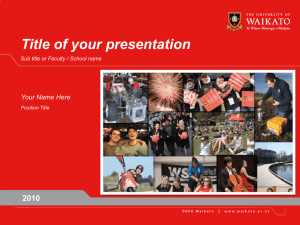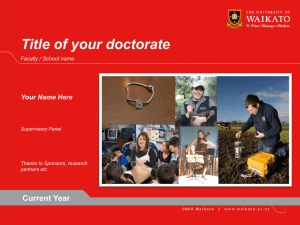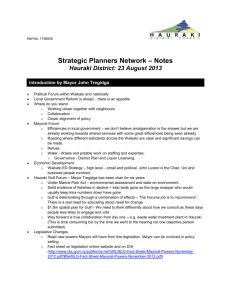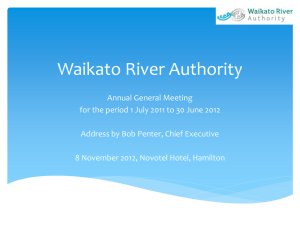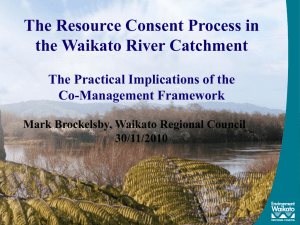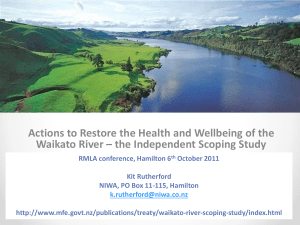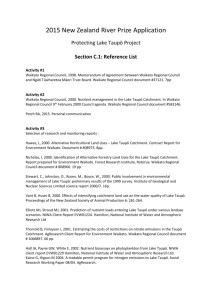Aquaculture - Hauraki Collective
advertisement
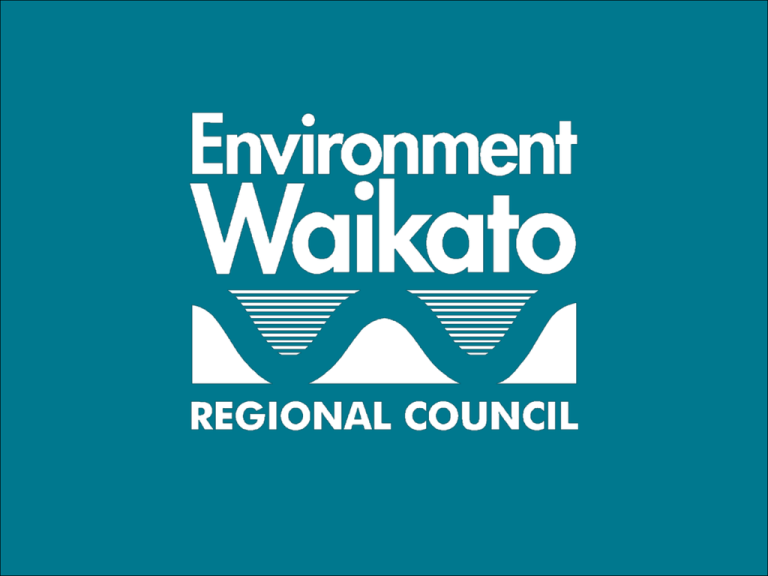
Agenda The Hauraki environment Coastal monitoring and studies Biodiversity Freshwater quality and quantity Works and services Policy initiatives Special project – Tui Mine Hauraki iwi boundaries The Hauraki environment Whitianga Land use (2008) 51% pasture 38% natural forest 8% planted forest 1% horticulture and cropping 1% wetland 1% towns Pastoral intensification (2002-2008) 64% no change. 26% moderate intensification. 9% major intensification. Coastal monitoring and studies Regional estuary monitoring since 2001 - ‘benthic’ animal communities and sediment characteristics in the Firth of Thames. Beach profile surveys since the 1970s - most of the Coromandel beaches. Estuarine vegetation mapping – one estuary every five years. Benthic habitat (shellfish) mapping for Tairua and Wharekawa estuaries. Sediment contaminants study in the Firth of Thames. Sources of sediment entering the Firth of Thames Kaiaua – Miranda Waitakaruru Coromandel Piako Waihou 7% 8% 8% 15% 63% Around 150,000 tonnes of sediment flows through from the Waihou each year. Mangroves sediment and nutrient 800 metres Modern day rate of about 19 metres per year. Past rates, 2 to 3 metres per year. Biodiversity Biodiversity and natural heritage Significant natural areas Environment Waikato has completed a desk top exercise to identify “significant natural areas” of native species habitat in the Coromandel. Several hundred potential sites have been identified, but these have not been ground-truthed. Natural heritage Repeated surveys have confirmed the community highly values the important natural heritage of Coromandel landscapes and beaches. Retaining public access to undeveloped beaches is a community priority and an Environment Waikato policy objectives. Biodiversity and natural heritage Community biodiversity projects: Environment Waikato and the Waikato Biodiversity Forum have supported groups restoring or protecting biodiversity sites on the Coromandel. For example, Kauri 2000 has been supported to plant thousands of trees, largely on Crown land. Animal pest control by community groups protects thousands of hectares of Crown land (e.g., Moehau Environment Group). Coastal, dune, and wetland restoration projects have been particularly active and successful. Pest plant and animal control Examples of work undertaken: monitoring of landowners’ compliance with pest control rules in the RPMS biological control releases managing direct control of high threat pest plants through contractors providing advice/information to landowners general surveillance for new pest incursions. Five years of goat and possum control undertaken so far - now in a maintenance phase. Native bird resurgence has been a secondary spin-off for the programme. Significant natural areas Identified for biodiversity prioritisation. 31% of Hauraki iwi area. Water quality and quantity Water quality and quantity Large dairying influence – approx 550,000 dairy cows. Nutrients in the rivers are high, but not rapidly increasing. Nutrient and contaminant runoff can potentially have ecological impacts on the southern firth, aquaculture and amenity. River quality 3 Total P Total N 2.5 mg/L 2 1.5 1 0.5 0 Waikato River Waikato River Hamilton Rangiriri Waihou Te Aroha 2007 data Piako – Tahuna Sources of nitrogen in rivers Nitrogen Nitrogen sources for the Piako River sources for the Waihou R gen sources for the Piako River 4% Piako River Waihou River 11% 4% 10% 11% Point sources 15% Background Land use Point sources Background Land use % 85% 75% 50 – 70 per cent of N in the southern firth is from land use. Total nitrogen 1992 - 2007 1 Decreasing N levels Increasing N levels No change to N levels Waihou river compared with other sites - ecology Waihou river compared with other sites - swimming Water allocation Piako is over allocated - between 200 and 600 per cent. Waihou River is about 80 per cent allocated. Ohinemuri catchment is over 100 per cent allocated. EW is investigating new minimum and allocable flows for the Waihou and Piako rivers. Variation 6 addressing these issues. Works and services Piako stopbank stability Coromandel Peninsula Project Aims to improve the health of the environment and reduce flood risks on the Coromandel Peninsula. Integrated approach to improve water quality and biodiversity, reduce sedimentation of rivers, harbours and estuaries and improve community safety. Multi-agency project – Environment Waikato, TCDC, DOC, Hauraki Māori Trust Board. Political management via Coromandel Liaison Subcommittee with agency, iwi and community representatives. Key issues – inappropriate development, climate change, pressure on coastal environment. Waihou Piako Waihou-Piako Zone works and services Historic and significant whole of catchment schemes. Annual spend - $7.8 million. Retiring land, improving land stability, reducing erosion and sediment runoff. Maintaining stream channels, controlling erosion, riparian plantings. Significant flood protection works protecting 60,000ha of land from river and tidal flooding (incl. Thames, Ngatea, Paeroa, Te Aroha). Political management via Waihou Liaison Subcommittee with agency, iwi and community representatives. Key issues – land use intensification, sea level rise, water quality. Kaimai Mamaku catchment management Kaimai Mamaku catchment management project underway with Environment Bay of Plenty and DOC to protect and enhance catchments on both sides of the range. A state of the environment report was commissioned between the parties with a view to determining priorities. Goat control in the southern Coromandel ranges is a joint effort with DOC for catchment and biodiversity enhancement objectives. Dedicated possum control in upper Piako catchment in Te Tapui Reserve for biodiversity enhancement joint funding with DOC and NZ Deer Stalkers. Consenting Water takes. Dairy factories. Meat works. Piggeries, chicken, dairy and marine farms. Regional landfill at Tirohia. Aggregate quarries. Forestry. Municipal sewage and stormwater discharges. Peat mining, Waihi gold mine, Tui Mine and Golden Cross closed mines. Timber processing operations. Navigation safety Ensures Waikato waterways are safe and navigable by: developing policy instruments ensuring compliance with the relevant policy instruments navigable waterways Promotion, education and compliance activities. Aids to navigation - lights and daymarks to identify hazards. Removal of obstructions that are hazards to navigation. management of moorings. Policy initiatives Regional Policy Statement review Contributions to the RPS review process from the Hauraki Māori Trust Board (HMTB) have given Environment Waikato a greater sense of their priorities, both locally and regionally. RPS will be notified in the next few months followed by the document going out for consultation. Hauraki iwi will have the opportunity to submit as part of the public consultation process. Coromandel Blueprint project Growth project for Coromandel Peninsula - has developed district wide strategy and local area plans currently being developed. Joint project with Thames Coromandel District Council (TCDC), Department of Conservation and Hauraki Whaanui. Will be implemented via TCDC’s district plan, Environment Waikato’s RPS and Regional Plan, DOC’s Conservation Management Strategy and iwi management plans. Aquaculture Aquaculture contributes $27 million to the region’s GDP on a turnover of $44 million (2007). Estimated 40 per cent of marine farming space is operated by Māori owned or part-owned businesses. Environment Waikato is trying to amend the coastal plan to allow the introduction of new types of aquaculture, such as fish farming, within existing farm sites and the zone. Environment Waikato intends to uplift the prohibition on aquaculture and replace it with discreet exclusion areas over sensitive sites. Marine farms (red) and Wilson's Bay zone (blue) B 1000 hectares consented for mussel and oyster farms. Another 520 hectares will be consented this year (Area B). 20% of Area B will be allocated to the Takutai Trustee (104 hectares). Hauraki Gulf Forum Environment Waikato is a big participant in this forum along with iwi, Auckland Regional Council, territorial authorities, DOC, Ministry of Fisheries and Ministry of Māori Affairs. Works to integrate management across the Gulf and its catchments. Must complete a state of the environment report every three years. Environment Waikato is a major contributor to this report. Special project: Tui Mine remediation Tui Mine remediation A contaminated site from acid mine drainage and two contaminated streams. $9.89 million budget allocated by MfE in 2007 to initiate the remediation works. Project objectives: contain the tailings within a stable and secure location reduce the release of contaminants into the Tui and Tunakohoia streams improve the geotechnical stability of the tailing impoundment improve the safety and security of the site improve the visual appearance and aesthetics of the site. Minister for the Environment is now assessing funding options for an additional $7.62 million needed to complete the remedial work. Tui mine Tui Stream Waihou River Tunakohoia Stream Champion level 4 portal and waste rock stack Champion level 5 portal and waste rock stack Process area Tailings dam Access road
